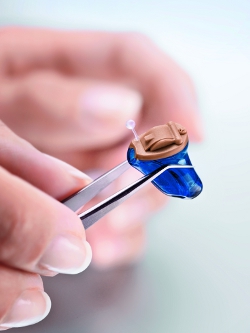
For the nearly 28 million Americans who suffer from hearing loss, each day presents a series of missed opportunities and challenges. At their most basic level, hearing aids offer their wearers the opportunity to listen, react, and interact in an environment of rich sounds. Using hearing aids, many people can have up to 100% of their hearing loss restored. Listen in on life’s greatest sounds: your children’s laughter, the upper register of a soprano, or even the gentle whirring of the vacuum cleaner. Hearing aids make it possible for the hearing impaired community to enjoy life on the same level as their friends and family.
Hearing Aid Parts
Hearing aids are small electronic devices that amplify sound. They are almost always made up of four integral parts:
- Microphone. The hearing aid kicks into action when a sound is “picked up” by its microphone. The microphone converts in into an electric signal and sends it to the amplifier.
- Amplifier. The amplifier increases the volume of the electrical signal and sends it to the speaker.
- Speaker. The speaker translates the amplified electrical signal back into a sound—the kind that human beings can interpret. The sound is then transmitted to the brain.
- Battery. Since hearing aids are electronic, they must be powered by a battery. Some batteries are rechargeable.
The Hearing Spectrum
In humans, the hearing spectrum is determined by a person’s ability to hear a range of frequencies, or pitches. These frequencies are caused by the number of vibrations that a sound makes when it hits an eardrum. Frequencies are measured in Hertz, with one sonic wave per Hertz. Under ideal conditions, humans can hear frequencies as low as 12 Hz and as high as 20 kHz in children and some adults. The hearing spectrum narrows beginning around the age of 8. Women typically have a broader hearing spectrum than men.
Digital vs. Analog Hearing Aids
While digital hearing aids amplify different sounds at different levels, analog hearing aids amplify all sounds equally. This presents a problem when a person is in an environment with many different noises. Imagine being at a baseball game and hearing the voice of the friend sitting next to you, the yells of the hot dog vendor in the aisle, and the booming voice of the sports announcer over the loudspeaker all at the same volume. Analog hearing aids are less costly than their digital counterparts, but financing plans have made digital hearing aids more accessible. The vast majority of the hearing aids used in the United States are digital. Analog hearing aids are in the process of being phased out.
Call 877-631-9511 for FREE Consultation



